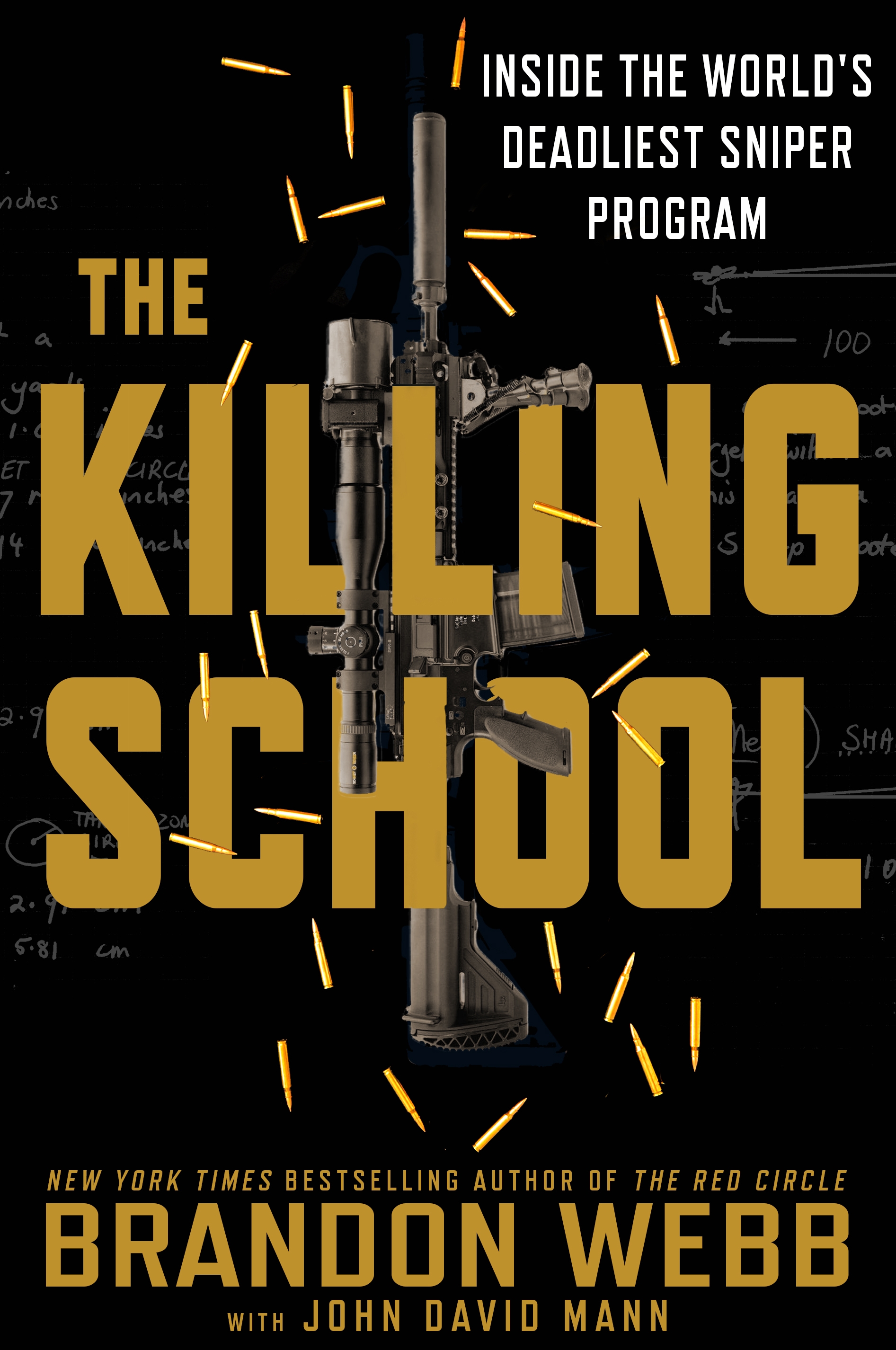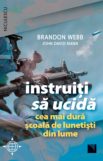The Killing School
Inside the World’s Deadliest Sniper Program
“I HAVE AN UNUSUAL relationship with death.…”
So begins a saga, a story of war and training, of death and life, and also by any measure (certainly by word count) the biggest book I’ve ever written.
“For most of us, death is a mystery, a thing we fear and seek to avoid, evade, or deny, even to the point of pretending it doesn’t exist, at least until we reach our sixties or seventies and it starts coming around to claim the lives of those we know and love. For me, the face of death is as familiar as the barista at my local coffee shop. … Orpheus may have tricked Hades; Ingmar Bergman may have had Max von Sydow play chess with Death; but those are only stories. In real life, death isn’t something you cheat or outmaneuver. Death is like the wind: it blows where it wants to blow. You can’t argue with death; you can’t stop it. Best you can do, as any sailor will tell you, is your damnedest to harness it.…”
The Killing School weaves the story of four snipers — a Navy SEAL, a Marine sniper, an Army Ranger, and a Canadian infantry sharpshooter — in four different battles over the span of fourteen years, from Mogadishu to Afghanistan to Iraq. It tells their stories, from childhood through enlistment and basic training, through sniper selection and the honing of superhuman skills that comes with sniper school, onto the battlefield and home again. It tells of their quest to become the best, as well as their struggles to come to grips with the brutal facts of their deadly mission.
Actually, make that five snipers, since the story is narrated by my buddy Brandon Webb, who served as a Navy SEAL sniper and was then tapped to help redesign and run the Naval Special Warfare sniper training program. The book’s centerpiece, chapters 5 and 6 (“The Platinum Standard” and “Zen Mind, Lethal Mind”), describe in detail his experiences in reshaping the SEAL sniper school, including his innovative course of mental management (read: self-talk, visualization, and mental rehearsal) that took their attrition rate from 30 percent down to one percent.
The book’s structure, with its accelerating pace cross-cutting back and forth between four different battle scenes, may be the most unusual writing challenge I’ve ever taken on. Its last chapter, “Taking Life,” is probably the most soul-searching writing Brandon and I have done together. The last few paragraphs of its epilogue, “Alive,” gave me chills when they spilled out onto the page. (But do yourself a favor: don’t skip ahead. The effect is better if you start from the beginning, and wait for it.)
Foreign Language Editions
Also available in Polish and Romanian; Chinese (simplified) and Japanese editions coming soon!
The Killing School Reviews
“Profound … As you read all the real-life accounts in this book you’ll find they feel so honest and read so well it is hard to put the book down. The Killing School is a bright window into the shadowy world of our elite snipers.” — Forbes
“This deep, gripping book provides a comprehensive look at what it takes to be and train a SEAL sniper.” — The Shooting Wire
“Delivers a training-of-elite-forces narrative in full—and much more. The Killing School goes into gripping detail about the training needed to create a master sniper.” — The Australian
“Calling The Killing School a ‘war book’ is like saying Philip Caputo’s A Rumor of War is only about Vietnam, or that William Manchester’s Goodbye, Darkness is only a WWII memoir. The Killing School takes us deep into SEAL sniper training; it introduces us to the people who do these things for us; and it exposes the often-unreported realities of the battlefield. Most of all, it gives even those of us who haven’t served a deep look into what American warriors do.” — “If You Liked American Sniper, You’ll Love The Killing School,” America’s First Freedom
“Sure to scare the hell out of any terrorist in line for a well-placed sniper shot. The Killing School is a gritty behind-the-scenes look at what makes the modern sniper so lethally effective in combat.” ― Dick Marcinko, founder and first commanding officer of SEAL Team 6, author of the bestselling Rogue Warrior series
“The Killing School reads like a screenplay for the most cinematic military adventure flick you’ve ever seen—except that every word of it is true. Brandon Webb is the real deal, and so are the four Spec Ops snipers whose exploits he traces with pulse-pounding detail.” — Kris “Tanto” Paronto, former Army Ranger, GRS operator, and coauthor of the New York Times bestseller 13 Hours
“Very few people on this earth know what it’s like to sight through a scope, pull a trigger and in the line of duty, stop another human being’s beating heart. Read The Killing School. Then you’ll know.” — Clint Emerson, formerly of SEAL Team Six and NSA, bestselling author of 100 Deadly Skills
“There were many reasons Chris Kyle (American Sniper) became the deadliest sniper in U.S. military history. Brandon Webb’s contribution to the SEAL sniper course—their killing school—was a key factor in Chris’s journey.” — Scott McEwen, #1 New York Times bestselling coauthor of American Sniper and American Commander
“An important piece of Naval Special Warfare history—and one hell of a gripping read!” — Dakota Meyer, former USMC Scout Sniper, Congressional Medal of Honor recipient, New York Times bestselling author of Into the Fire
Excerpt from The Killing School
I’ve never drowned to death, but I’ve come close. I’m not saying we were literally waterboarded during the course of our training, but let’s put it this way: I’m familiar with how it feels to be surrounded, invaded, swallowed by water, that intimate sense of skin-close death. I’d already known it for years. At the age of thirteen, I would dive deep down in the middle of the night, into the inky green blackness, to wrestle free a tangled anchor attached to the boat where I worked. There’s something primal about being taken over by water, something deeply peaceful even as it terrifies you. “Ashes to ashes,” goes the familiar funeral patter, “dust to dust…”—but it’s not really like that. Dust isn’t where we started. We came from water, and the water is always ready to claim us back.
Right now Alex Morrison was mulling over thoughts about death and water, as he felt their craft heave and plunge in the midnight African sea swell.
Alex had been a SEAL since 1989, graduating from the Naval Special Warfare sniper program in mid-’94, less than a year earlier. The son of a marine officer, he had joined the teams out of an unquenchable thirst for adventure. He had the feeling he was about to get some.
He looked around, craning his eyes in the dark.
There were about forty of them, crammed onto their bench seats in the dark, packed like heavily armed sardines into a corrugated steel MILVAN shipping container fastened to the deck of an amphibious hovercraft, speeding toward the Somali coast, a few miles still to go. They couldn’t see out, not that there was much to see at midnight on the ocean; still, if they were out on deck at least they would have been able to see the stars and get a sense of horizon. If something happened, they would have been able to do something.
No dice. All they could do was think about the mission in front of them.
“Operation Restore Hope,” that’s what they’d called it back in 1992 when it started. An international effort to bring order and stability to war-torn, famine-ravaged Somalia. All you had to do was look at the Battle of Mogadishu in October 1993 to know how that plan was turning out.
More like Operation Hopeless, thought Alex.
And now that they’d pulled the plug, someone had to go in and get the last few thousand U.N. personnel who were still there, housed in complexes in and around the coastal airport. They couldn’t be airlifted out—too many crazy, khat-chewing Somali militia running around with surface-to-air missiles. They couldn’t leave via commercial shipping, either: too many mortars, RPGs, and so on. It had to be a military operation, and a delicate one at that. Which was why Alex and his platoon were there.
The operation employed a total of about fourteen thousand personnel, though only a fraction of those were being used in the actual landing force. Most would remain on board the Coalition fleet of two dozen ships, four miles off the coast, to receive the evacuees and support the mission. It would be the largest amphibious withdrawal under hostile conditions since we’d pulled out of North Korea in 1950.
About half the landing forces would put in at Mogadishu’s seaport, just north of the airport, in large landing craft. Hundreds more would roll in on amphibious assault vehicles, essentially large waterproofed tanks. Some were flying in on helos. Not Alex. He and the other sardines were hovercrafting straight onto the beach by the airport runway, where he and their platoon’s other sniper would immediately fan out with their support teams and establish overwatch for the duration of the mission. Which should go smoothly—not a shot fired. After all, Mohamed Aidid and the other Somali warlords had been talked with, and had agreed to let the U.N. forces go peacefully. But of course, they had added, they couldn’t be responsible for the actions of militias or splinter groups, now could they?
To put it in plain English: once the evacuation began, all bets were off.














